Kristine Hughes's Blog, page 88
August 22, 2014
TEA AT FORTNUM & MASON
Recently, we ran a post containing an essay written by film critic Roger Ebert about his memories of London during the 1960's. Soon after, we came across this piece written by M.E. Foley that first appeared on the Anglo-American Experience Blog on February 1, 2010, about her first experience of having tea at Fortnum and Mason. We enjoyed it so much that we thought we'd share it with you - enjoy!
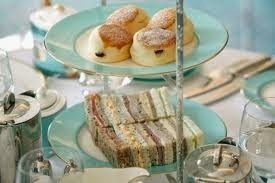
About ten years ago, a friend invited me to Fortnum and Mason for tea. Last week, I finally got there.Fortnum and Mason has been a London institution for more than 300 years, since Mr Fortnum, a shopkeeper, and Mr Mason, a royal retainer with a sideline in selling off the unused lengths of candles from the palace, joined forces in the earliest 18th century. Whenever Queen Anne needed light, only a new candle would do, so Mr Mason had access to a lot of excess royal wax.Fortnum and Mason is famous for its groceries, though the shop has other departments. But these are not run-of-the-mill groceries. The store used to have a whole department just for outfitting expeditions—by which I mean serious attempts to climb Everest, and the opening of King Tut’s tomb. Queen Victoria bought supplies for Florence Nightingale from Fortnum & Mason, and had them dispatched to Nightingale’s hospital in the Crimea.Today it’s the kind of grocery in which you find oranges and lemons steeping in ornately curved bottles of Muscadet vinegar, or find stacks of gift hampers packed with Stilton or port. The store’s own line of marmalades includes seventeen flavours, some of which can be had in your choice of ordinary jars, ceramic crocks, or “glass amphorae”. For a mere £85 you can get 3 pounds of chocolate Easter eggs that nest, seven-deep, matryoshka-doll style. To call the marzipan fruits miniature works of art leaves me without a superlative left to describe the even-more-beautiful glacé fruits —slices of kiwi and pineapple saturated with sugar syrup, which leaves them looking as if they are about to burst with juice at the same time as they seem to be set into crystal.And then there are the teas—too many varieties to count. Okay, a Safeway or Sainsburys will stock a lot of teas, but I don’t think they carry Jin Shang Tian Hua, sold with the leaves sewn into the shape of chrysanthemum buds that unfurl in hot water so as to make it seem that the flowers bloom. The buyer is advised that the effect is seen to best advantage in a tall glass cup. At £175 per 125 grams (so a little over $1000 per pound, then), you won’t want to miss any of the unfurling.The store offers three restaurants, an ice cream parlour, and a wine bar, and two of the restaurants serve afternoon tea. As I’d spent the day mooching around the stacks at the London Library, I wasn’t dressed for the more formal restaurant (the St James), nor did I necessarily need the full tea with finger sandwiches, cakes, scones, and biscuits, nor did I want to spend £32. So I decided on the Fountain Restaurant and settled at a table by the window. I’ve had lunch there a few times, but never tea, so opened the menu to see the choices, but the waiter was with me in a flash.I couldn’t place his accent, but thought he might be Italian. I was served by four other waiters in the course of my visit—well, one was a waitress—and not one of the five was English, but that’s not unusual in London. Like all the staff, the fellow who took my order wore a white shirt, gray waistcoat, and pink tie, with an old-fashioned long white apron to protect his trousers.He pointed across the room to the cakes—chocolate, Victoria sponge, and something that I couldn’t understand given his accent, but among the words I identified “like caramel”. Scones, I thought, would suit the occasion better, so I ordered tea and scones.“What kind of tea?” he asked.“Assam, please.” That’s my usual.He looked concerned, and asked me a question I couldn’t understand.“Excuse me?”He pointed to the menu. “This one?”I glanced down; I hadn’t noticed the list of teas. It said Assam, though, and seemed to have a bunch of adjectives around it, the way some restaurant menus do. I told him that would be fine.The tea duly arrived in a silver pot, with a silver strainer and a small silver vessel to set the strainer in when I was finished straining. And the scones came, two of them. They were…well, to put the best face on it, I’ll say they were petite. I had expected small scones; Fortnum & Mason is traditional, so I didn’t think they’d serve the gigantic scones and behemoth muffins you find in the US, but these scones were practically microscopic. The blobs of butter and strawberry jam also on the plate were about the same size as the scones. And where was the milk for the tea?I asked this new waiter for some milk.“You want milk?” he asked, as if he’d never heard of such a thing.Of course I wanted milk. This is England! Almost everybody has milk in their tea. And I also asked to see the menu again, to read about the different teas, because the first waiter appeared so fast I didn’t get a good look. Another server came with milk in a small silver jug, and yet another one provided a menu. And there I found my mistake.The menu offered the microscopic scones for £7, but that was with ordinary tea. The only Assam tea on the menu was a single estate tea: Assam Mohokutie Second Flush, from “one of the oldest tea estates located in the Doom Dooma district, south of the Great Brahmaputra River.” I read that Mohokutie means “the buffalo camp”, and that “the leaf is wiry and tippy, producing a malty golden liquor.”And I also read, rather too late, that it cost an extra £10. Oops. That’s just for the tea, on top of the charge for the scones. I was out £17 (30 bucks) already, and definitely out of my league.But since I was going to have to pay for it, I decided to sit back and enjoy every bit of it. The waiter had advised me to let the tea steep a minute before pouring, so I read about the other single-estate teas. It could have been worse. I could have accidentally ordered the Tregothan Black from Cornwall—yes! Truly English tea, actually grown here, but at £34 per pot (not far shy of $60), I won’t be trying it any time soon. Doubtless each tea bush is watered by a platinum irrigation system, and is warmed on cold evenings by the breath of local horticulturists, chosen for the task personally by Prince Charles, as Cornwall is his Duchy.In the same price range as my Mohokutie, however, I might have chosen Yunnan Golden Needles or Pi Lo Chun. The former, according to the menu notes, is of such a calibre that you can tell it was picked with “fine plucking standards”, and it is called needles because the leaves have been rolled into thin, pointy shapes—presumably by the delicate hands of select maidens whose families have been rolling tea into needles for millennia, carefully guarding their secret technique. The latter is said to have an especially fruity flavour which it “absorbs” from the “aroma” of peach blossoms on trees grown nearby. I’m not at all sure that it’s scientifically possible for leaves to soak up the aromas of their neighborhoods—but what do I know? Until I read that menu, I hadn’t know there was tea grown in Cornwall, or tea with hand-rolled leaves, or tea that cost 60 bucks per pot. Maybe that’s why there are few teas grown in urban areas; nobody would want tea tasting of car exhaust, litter, and graffiti.My Mohokutie Second Flush did have a gorgeous golden colour, somewhere between clover honey and the butterscotch candies we used to have when I was a kid. (I’m sure that real tea connoisseurs have a more sophisticated vocabulary for shades of tea.) I’m not sure I identified any malty flavours, and I didn’t think the taste so special that milk should be forbidden, so I tried a cup that way. Big mistake. With milk, the colour was more pavement-puddle brown than golden. The taste wasn’t anything to write home about, either. I decided to have the next cup milkless, but by the time I was ready for it, the tea in the pot had stewed, as they say here: over-steeped, yielding a colour you might call mahogany brown.The tiny scones, by the way, were fabulous. So flaky you couldn’t spread anything on them, but the butter and jam were redundant, anyway. The scones were so rich and so sweet that adding anything would only detract.So I enjoyed my solitary tea at Fortnum and Mason, and lifted a cup to the friend who had invited me so long before. Through the years, we never had found a convenient time for that much-discussed tea. It came to be a joke, that someday we’d have tea at Fortnum and Mason, but we never made it a priority because Fortnum and Mason would always be there, and we had all the time in the world.Alas, we didn’t. The last time she mentioned it, it was in a wistful way because by then we knew it would never happen, and she’s no longer with us.So I’ve resolved to go ahead and do some of the things I’ve always wanted to do. I highly recommend it. If you’re British and you want to see the USA, get your tickets. If you’re American and you’ve always wanted to visit the United Kingdom, come on over. Maybe we’ll have tea at Fortnum and Mason. But perhaps not from the single estate tea portion of the menu.
Published on August 22, 2014 00:00
August 20, 2014
VIDEO WEDNESDAY: LIVE UK WEBCAMS
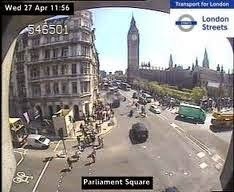
Today we bring you links to some webcams in use in the UK in order to share interesting sites throughout Britain. Sit back, pour yourself a cuppa and enjoy a varied tour through the lens of these cameras.
Trafalgar Square
Tower Bridge
Sussex Gardens, Paddington
Abbey Road (lots of silly beggars recreating the Beatles walk)
The Cobb, Lyme Regis, Dorset
Interior of barn, Donkey Sanctuary, Sidmouth, Devon
Ordsall Hall Ghost Cam
The beach at Bognor Regis
Market Square, Petersfield, Hampshire
Three webcams in Oxford
Inside the Arnside Chip Shop
Edinburgh Zoo panda cam
Whitby Harbour - 3 views
Wookey Hole Caves
The Peregrines at Norwich Cathedral
Lake District National Park webcams
Dublin Zoo webcams
Published on August 20, 2014 00:00
August 18, 2014
LORD ALVANLEY REVISITED
From The Letter-bag of Lady Elizabeth Spencer-Stanhope, Volume 1
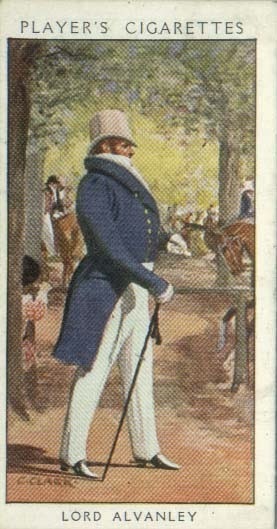
Marianne Spencer-Stanhope writing to John Spencer-Stanhope.
Paris, March, 1818."I hear nothing of the man taken up for shooting at the Duke, if it is true that one has been secured. Poor Bacon was taken up by 5 Gens d'Arms at nine in the morning and after a secret examination sent to the Conciergerie. It was conjectured he was concerned with a Banker who went off—but instead of that being true, the Banker absconded with all his money! Sir C. Stuart means to make a fuss about it, for no one is safe if taken up and confined only on suspicion."The King on one of the most stormy days we have had took three people out to prevent their voting for the Recruiting Bill. However, they contrived to get back in time, by which means it was carried by four. He was angry—they said they did it as a point of duty to him."Lady Mansfield's Ball was fine—but too many women in proportion to the men, and many of the latter old. A great many French. I only saw oneLady out of each family. Many, many young ladies sat out. All the ton French ladies danced the whole night. Lady M. hoped she should see you, tho' she forgot to invite you."Lord Alvanley came to Paris a few days ago with his mistress. They refused him admittance at the Hotel de Londres, saying they had English families there, among others "the great Mrs Beaumont," He coolly replied that they need not mind her, for her fortune had been made by keeping a house of bad character; and so he got in! Did you ever hear of such scandalous impudence!"
On behalf of Lord Alvanley, however, it may be added that about this date another story got abroad respecting him which redounds more to his credit . He and Lord Kinnaird were playing whist one evening, when, owing to some mistaken move in the game on the part of Lord Alvanley, Lord Kinnaird completely lost his self-control and abused his friend in the most violent manner. Lord Alvanley listened in silence to the torrent of denunciation, then, rising from the card table, observed very quietly, "Not being blessed with your Lordship's angelic temper, I shall retire for fear of losing mine!"Moreover, Marianne Stanhope, about the same time, makes mention of an instance of Lord Alvanley's good-nature which came under her notice. It appears that one of his greatest friends was an Irish dandy who, for long, went by the nickname of "King Allen" on account of his having achieved a unique position in the world of fashion. This monarch of the beau monde spent his days, as did others of his class, exhibiting his faultless clothes in fashionable resorts; and so wedded was he to this existence that he could seldom be persuaded to quit London even for the benefit of his health.
Once, however, Lord Alvanley found his friend moping at the sea-side, a prey to profound depression, and spending sleepless nights tossing on his couch, unable to account to his own satisfaction either for his insomnia or his melancholia. With the intuition of a kindred soul Lord Alvanley at once probed the root of the dandy's complaint. He recognised that it was impossible for such a man to exist apart from the bustle and noise of the great city to which he was accustomed, and faute de mieux, Lord Alvanley invented a remedy. At his own expense, he engaged a hackney coachman who undertook to rattle his vehicle up and down past King Allen's lodgings till the early dawn, and another man who agreed to shout the hours throughout the night in the strident tones of a London watchman. The ruse was successful. Whether other persons living in the neighbourhood were equally pleased, history does not relate, but the melancholy dandy, deluded into a belief that he was back once more in his favourite haunts, slumbered peacefully, and was in time restored in perfect health to the scenes of his former triumph.Indeed, "Lord Alvanley," wrote Lady Granville at a later date, "was quite charming which does not mean homme, but I cannot persuade myself that he is much altered and that he will end by being a very good, as he is a most captivating, person. Such cleverness, without one grain of effort. What a receipt for being, as he is, quite charming."
Published on August 18, 2014 00:00
August 15, 2014
THE DUKE OF WELLINGTON TOUR: SLOANE SQUARE

During our upcoming sojourn in England, one of the neighborhoods Victoria and I will be staying near is Sloane Square, in Kensington. It's not an area I've stayed in before, so I'm looking forward to exploring the area more fully this time over. While I'll be arriving in London at 6 a.m., Victoria won't be landing at Heathrow until 6 p.m., so I'll be on my own for the better part of the day.
I think I'll first stroll down the King's Road and browse the shops on my way to Caffe Nero for that cup of coffee I've been anticipating for so long. Perhaps I'll stop into the nearby Waterstone's Books for a browse before retracing my steps to Royal Avenue, with it's 19th century terraced houses, one of which was home to Bond, James Bond. This Avenue will bring me directly into Burton Court, a 14 acre green space that holds ancient trees and the Brigade of Guards cricket ground and backs directly onto Chelsea's Royal Hospital.
The Royal Hospital is yet another of those places I've always meant to visit, but have never gotten around to seeing. And it's yet another place with connections to the Duke of Wellington - will Victoria and I ever run out of people, places and things connected to the Duke of Wellington? More on that soon . . . . but for now we begin the Wellington connections to the Royal Hospital with his commission of that famous painting, The Chelsea Pensioners Reading the Waterloo Despatch, by artist David Wilke. You can read a prior post about the painting here.
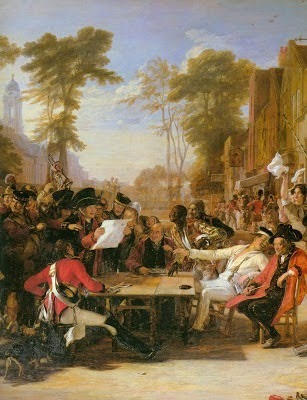

A second Wellington connection is the Hospital's Great Hall, designed by Sir Christopher Wren, where Wellington's body lay in State in 1852. In addition, there's a Museum that features military artifacts, including items associated with the Duke, as well as other uniforms, weapons, models, etc. After the Royal Hospital Museum, I may just mosey down to nearby Ranelagh Gardens, another site I've been meaning to visit. It's the site of the present day Chelsea Garden Shows and has been incorporated onto the Hospital's estate.
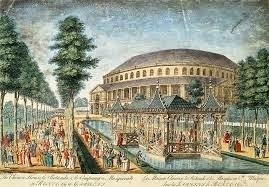
Of course, the Ranelagh Gardens of the 18th and 19th century is long gone and the Rotunda, Chinese Pavillion and lantern lit lanes are no more, but how glorious would it be to tread on the same ground where dandies, powdered ladies and the haute ton once paraded on summer evenings? Remember, by this time of day I'll still have about six hours to fill before Victoria arrives at our hotel, so I may just head up to Piccadilly and take a London Walk . The Old Palace Quarter walk sounds like fun. Strange, is it not, that someone who leads tours and walks themselves should want to take someone else's tour? I suppose we all like to be led round London and entertained with historic tales.Afterwards, I plan to visit Hatchard's bookshop. I reckon it will be about 4 p.m. by now and I'll have a couple of hours to browse the books before returning to our hotel in order to meet Victoria. A quick wash and brush up for her before we toddle out for out first of many dinners together in England. And where, you ask, will we be dining? At the Duke of Wellington pub, of course. Or, as it's more cheekily referred to - The Duke of Boots.

Published on August 15, 2014 00:00
August 13, 2014
RIDE THE RETREAT - MONS TO THE MARNE
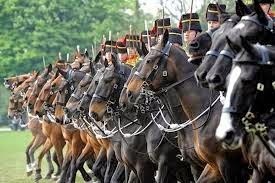
England has undertaken some fabulous events to mark the centenary of WWI. The BBC aired a program called World War One Centenary: As It Happened, the Tower of London is installing 888,246 ceramic poppies in the dry moat to commemorate the Allies who lost their lives in that battle and on August 4th Britain turned out it's lights and lit candles to in an act of remembrance.
Anniversary events will continue throughout the year, but one of the largest undertakings has to be Ride the Retreat - Mons to the Marne.
To commemorate the opening actions of the British Army in the Great War, Ian Woodbridge and Dr David Kenyon are riding the retreat from Mons in Belgium to the River Marne in France for The Horse Trust and the Army Benevolent Fund. You can read about the Great Retreat here.
The ride will take place over two weeks covering over 200 miles in eleven separate stages and will visit all the major cavalry engagements coinciding with the 100th anniversaries of each event. They hope to help people experience the opening actions of the Great War and to explain the role of the cavalry during the great retreat conducted by the Cavalry Division of the British Expeditionary Force during late August and early September 1914.
For more information and regular updates, please visit and like the Retreat's Facebook page.
The Horse Trust, one of the charities that will benefit from funds raised for the Ride, is the oldest horse charity in the world, founded in 1886 to help working horses in London.
From The Horse Trust website:
In 1877, English author Anna Sewell published a groundbreaking ‘autobiography’, the story of a working horse told through the horse’s own eyes. Black Beauty went on to sell over 50 million copies and become one of the best-selling books of all time. A few years later, a Miss Ann Lindo of North London
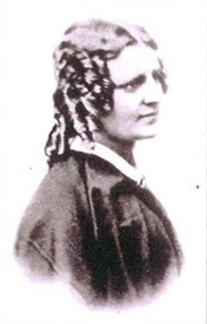 read Black Beauty and was inspired. A working horse had no rest in those days - their owners depended on the horse to earn money to feed their families. Horses pulled taxi cabs and delivery wagons until they dropped. Ann Lindo’s idea was to provide a place where sick and exhausted horses could rest and recover - lending in their place healthy animals so the owners could still earn a living.he Home of Rest for Horses was founded on 10th May 1886. Horses were bought or donated as loan horses, and demand was immediately high. Miss Lindo saw her idea become a great success and attract prestigious supporters, but sadly died only five years later, at the age of just 52. In 1900, London needed some 300,000 horses to keep it moving. Most of them, and most of our earliest patients - were the horses of cabmen.
read Black Beauty and was inspired. A working horse had no rest in those days - their owners depended on the horse to earn money to feed their families. Horses pulled taxi cabs and delivery wagons until they dropped. Ann Lindo’s idea was to provide a place where sick and exhausted horses could rest and recover - lending in their place healthy animals so the owners could still earn a living.he Home of Rest for Horses was founded on 10th May 1886. Horses were bought or donated as loan horses, and demand was immediately high. Miss Lindo saw her idea become a great success and attract prestigious supporters, but sadly died only five years later, at the age of just 52. In 1900, London needed some 300,000 horses to keep it moving. Most of them, and most of our earliest patients - were the horses of cabmen.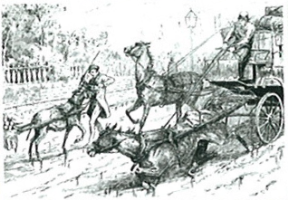 The others worked for traders like laundrymen, grocers or rag-and-bone men. There were 11,000 horse-drawn cabs working London’s streets in 1900. An owner-driver would take the best care he could of the horse on which he depended, but some horses were rented by the day, and each driver would work the horse as hard as possible. A horse’s life was relentless, hard, hard work.A steady stream of exhausted horses came to the Home for treatment. The charge for hiring a replacement was set at 25 shillings per week (about two days earnings). Feed for the rental horse was included, to make sure the hired animal was well-fed while out working.
The others worked for traders like laundrymen, grocers or rag-and-bone men. There were 11,000 horse-drawn cabs working London’s streets in 1900. An owner-driver would take the best care he could of the horse on which he depended, but some horses were rented by the day, and each driver would work the horse as hard as possible. A horse’s life was relentless, hard, hard work.A steady stream of exhausted horses came to the Home for treatment. The charge for hiring a replacement was set at 25 shillings per week (about two days earnings). Feed for the rental horse was included, to make sure the hired animal was well-fed while out working.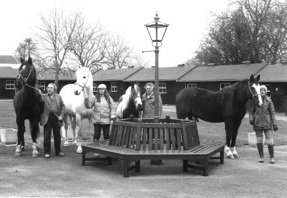 An early object of the charity was to provide a home for “Old Favourites,” giving them in return for a remunerative charge a pleasant home and every comfort and attention during their declining years.”In 1916 the charity temporarily stopped admitting Old Favourites due to the continued increase in price of forage during WWI. The cost of oats increased from 23s to 39s, and hay increased from £3 19s to £5 15s. Admissions were resumed in 1919 only to be suspended once more in 1943. The effects of rationing were so severe that Old Favourites could not be admitted again until 1951, 6 years after the end of WWII.
An early object of the charity was to provide a home for “Old Favourites,” giving them in return for a remunerative charge a pleasant home and every comfort and attention during their declining years.”In 1916 the charity temporarily stopped admitting Old Favourites due to the continued increase in price of forage during WWI. The cost of oats increased from 23s to 39s, and hay increased from £3 19s to £5 15s. Admissions were resumed in 1919 only to be suspended once more in 1943. The effects of rationing were so severe that Old Favourites could not be admitted again until 1951, 6 years after the end of WWII. 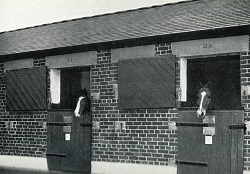 These Old Favourites included War Horses who’s Officers paid for them to enjoy a peaceful retirement when they returned from the battlefield. One such Old Favourite was Holly, a grey German charger captured in Italy at the end of the war. She was admitted after several years useful riding school work in this country. “The owner having stated that Holly was extremely nervous of explosions caused the Secretary and his wife to take turns at visiting the mare’s box on the fifth of November.”Many horses like Holly were ‘sold down the chain’ being passed from owner to owner as they became older or were injured and their value declined. Sadly, some of these horses ended up being neglected or overworked as a result. A story that is still all too common today. For the lucky few a kind owner paid for them to enjoy a gentle retirement at The Home of Rest for Horses.
These Old Favourites included War Horses who’s Officers paid for them to enjoy a peaceful retirement when they returned from the battlefield. One such Old Favourite was Holly, a grey German charger captured in Italy at the end of the war. She was admitted after several years useful riding school work in this country. “The owner having stated that Holly was extremely nervous of explosions caused the Secretary and his wife to take turns at visiting the mare’s box on the fifth of November.”Many horses like Holly were ‘sold down the chain’ being passed from owner to owner as they became older or were injured and their value declined. Sadly, some of these horses ended up being neglected or overworked as a result. A story that is still all too common today. For the lucky few a kind owner paid for them to enjoy a gentle retirement at The Home of Rest for Horses. 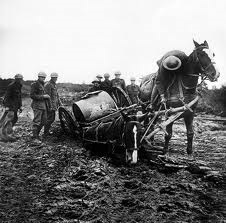 The First World War (1914-1918) saw millions of men and horses bogged down in horrific conditions in the muddy trenches of Belgium and Northern France. As Britain’s men were called away to war - including staff from The Home of Rest for Horses - and as shortages began to bite, The Home faced a threefold problem.
The First World War (1914-1918) saw millions of men and horses bogged down in horrific conditions in the muddy trenches of Belgium and Northern France. As Britain’s men were called away to war - including staff from The Home of Rest for Horses - and as shortages began to bite, The Home faced a threefold problem.Demand rose for our services as healthier animals were requisitioned for the war effort, leaving only older and sicker horses to cope with regular work. The men working the horses - and indeed caring for them at The Home of Rest - were often older or less experienced, and prices rose dramatically as supplies grew scarce. On top of this, the demands of war pulled financial support in other directions.
In spite of all these difficulties, the War drove the charity to new heights. Annual donations were made to RSPCA appeals in support of Russian Army Horses.
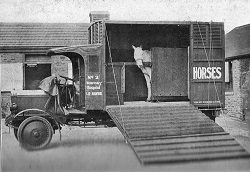 In 1914, the Committee made an inspired gift to the Army Veterinary Service of the first ever motorised horse ambulance. This proved so useful in moving injured horses from the battlefields for treatment that 13 more were procured and, by the end of the war, over 2 million horses had been successfully treated and returned to duty.The War had a major impact on everyday life, making it harder to get supplies as labour grew scarce and transport more difficult.At the end of the Great War we began taking in the first of our military veterans. The tradition continues to this day.
In 1914, the Committee made an inspired gift to the Army Veterinary Service of the first ever motorised horse ambulance. This proved so useful in moving injured horses from the battlefields for treatment that 13 more were procured and, by the end of the war, over 2 million horses had been successfully treated and returned to duty.The War had a major impact on everyday life, making it harder to get supplies as labour grew scarce and transport more difficult.At the end of the Great War we began taking in the first of our military veterans. The tradition continues to this day.
 With the generosity of our supporters we are able to provide a dignified retirement to some of the horses who have given so much for our country.
With the generosity of our supporters we are able to provide a dignified retirement to some of the horses who have given so much for our country. CLICK HERE TO LEARN MORE ABOUT SPONSORING ONEOF THESE OLD FAVOURITES
Published on August 13, 2014 00:00
August 11, 2014
LADY CASTLEREAGH'S ZOO

It is a well known fact that Frederica, Duchess of York, was a huge animal lover and that she kept many pets at her country home, Oatlands Park. In fact, on my last visit to England, I went to Oatlands to see her pet cemetery with my friend Hester Davenport. It was only recently, however, that I discovered that Lady Castlereagh also kept a private zoo. Here is what Mrs. Arbuthnot wrote:
September 4, 1820 - Returned to town, having first seen Lady Castlereagh's establishment for animals. She has got an antelope, Kangaroos, Emeus, Ostriches and a tiger, which Lord Combermere brought from the West Indies for the Duke of Wellington and which the Duke gave to Lady C. It seemed very vicious and growled at us.
My great, good friend Susan Brown pointed me to the following passage, which she found on the Regency Reader:
Marked by several contemporaries to be devoted and quite in love, the marriage produced no children. Instead, Lady Castlereagh kept a menagerie of animals at their country home, Loring Hall in iron cages; contemporary George Berkeley said of her pets “ It seems a strange taste for a lady patroness at Almacks, and one of the most distinguished leaders of the beau monde, to attempt to rival Exeter Change in a small country residence…nevertheless at the gay fetes given by her during the season to her innumerable fashionable friends, no part of the entertainment was more popular than the exhibition of Lady Castlereagh’s pets.”
Berekley goes on to suggest that subordinates of Lord Castlereagh at the War Office tried to ingratiate themselves, while stationed abroad in India and Africa, by sending his lady wife a tiger (known to be bad-tempered), armadillo and other wild animals. She also had, as she told an American dinner companion, a mockingbird and flying squirrel–although the mockingbird would not sing. This discomfitted her, as she was wanting to procure a hummingbird from the US but was worried, once on English soil, that “it wouldn’t hum.”
Aside from her more exotic animals, Lady Castlereagh was adoring of her bull mastiffs, who were said to ride in the carriage beside her. It was one of these dogs that created a stir, when one bit Lord Castlereagh after he tried to intervene in a squabble."
For a brief bio of Lady Castlereagh, I direct you to Wikipedia:
Amelia Anne Stewart, Marchioness of Londonderry (20 February 1772 – 12 February 1829), from 1794 until 1821 generally known as Emily Stewart, Lady Castlereagh, was the wife of the Georgian era Irish statesman Robert Stewart, Viscount Castlereagh, who from 1812 to 1822 was British Foreign Secretary and Leader of the House of Commons. Well-connected by birth to the aristocracy and wife of a prominent politician who was Britain's leading diplomat during the close of the Napoleonic Wars, Lady Castlereagh was an influential member of Regency London's high society.
During the Regency of George IV, Lady Castlereagh, along with Lady Jersey, Dorothea Lieven, Lady Cowper, and others, was a Lady Patroness of Almack's, one of the first and most exclusive mixed-gender social clubs in London. In their role as Patroness, they had great influence over the ton , determining social acceptance by designating who might receive "vouchers" (entrance tickets) to Almack's, thereby setting and enforcing complex, unwritten social codes of the London social elite.
Credited with having introduced the quadrille to London, Lady Castlereagh is also remembered for having Almack's doors closed, without exception, at eleven o'clock, even once turning away the Duke of Wellington. Her own parties were considered dull, and her manner was somewhat eccentric: guests described her conversation as an endless flow of trivial information delivered in an odd detached manner.At their country home, Loring Hall, North Cray, Lady Castlereagh kept a private zoo, which featured antelopes, ostriches, kangaroos, and a notably bad-tempered tiger.
Do you know of any other sources that refer to Lady Castlereagh's zoo? If so, please leave a comment or send an email - thank you!
Published on August 11, 2014 00:00
August 8, 2014
ROGER EBERT'S LONDON

Recently, Victoria sent me the link to an article written by film critic Roger Ebert about the London he had known in the 1960's. Like us, Ebert had loved London, spent much time there and was fortunate enough to have uncovered many of the City's treasures - hotels lost in time, shops that sold bespoke goods, restaurants that were known for their specialty food and a host of the sort of characters who define London. What a treat this article is and now I'm sharing it with you. The only drawback to the piece is that most of the places and people Ebert wrote about are long gone. How I wish I'd been able to book a room at No. 22 Jermyn Street for our upcoming visit. Sigh.
Here's the link to the article. Enjoy.
Published on August 08, 2014 00:00
August 6, 2014
QUEEN VICTORIA'S PET ELEPHANT

Exotic animals owned by members of royalty are nothing new. In centuries past, foreign dignitaries and heads of state often gifted British royals and other diplomats with the rarest animals to be found in their parts of the world. In fact, the Tower of London was for over a century home to many of the specimens that found their way to England in this way until the Duke of Wellington declared that enough was enough and sent them all off to the London Zoo.
What is unusual is that Queen Victoria was once given an elephant - and kept it at Osborne House. From the Osborne House page at English Heritage:
Few members of the royal family have been quite as enthusiastic about their garden as Queen Victoria and Prince Albert. At Osborne they were able to indulge their desire for a fashionable garden, drawing inspiration from the gardens of Europe. Osborne offers an intimate glimpse into royal family life, where you can see the vegetable plots tended by the royal children, and the beach where Queen Victoria would go for a dip in the sea. But it wasn't just the queen who went for dip on the royal estate - upon receiving a gift of a elephant from the King of Abyssinia in 1884, the queen needed a place for the animal to bathe for a few days. It was decided that the existing cattle pond would do, and ever since the pond has been named the 'elephant bath'!
You can still see the Elephant Baths at Osborne today, in fact, it's purported to be the only one in Europe and it stands as a hazard on the the 7th hole at the Osborne Golf Club. It should be noted that the elephant wasn't the only one who enjoyed bathing at Osborne House. In fact, the entire Royal family enjoyed having a private beach of their own and often took advantage of the opportunity for sea bathing. You can read all about it in this Daily Mail article from 2012 about the re-opening of the private beach to the public and the return of Queen Victoria's bathing machine to the property.
.
Published on August 06, 2014 00:00
August 4, 2014
AND FROM ELSEWHERE ON THE WEB . . . . . .

Spitalfields Life - Beekeeping on the Isle of Dogs
Historical Hussies - Childbirth in Regency England
Grace Elliot - Henry VIII's Bedtime Habits
Downton Abbey Cooks - Mrs. Patmore's Apple Charlotte
Carolyn Harris: Royal Historian - A review of Queen Anne: Patroness of Arts
Two Nerdy History Girls - The truth about big hair of the 1770's: How they did it.
The Duchess of Devonshire's Gossip Guide - Tart of the Week: Eglantine, Lady Wallace
Published on August 04, 2014 00:00
August 1, 2014
THE DUKE OF WELLINGTON TOUR: MORE LONDON FOOD
Victoria here, following up on Kristine's take on London food...Bangers and Mash? I think not! For Pub Food, I love Steak and Kidney Pie. Or Shepherd's Pie. Or a Ploughman's Lunch of cheddar cheese, bread and pickles...
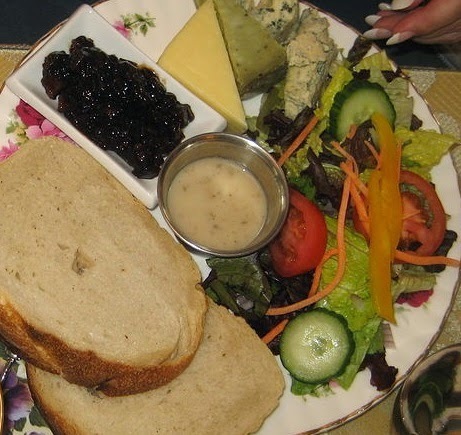 A fancy Ploughman's Lunch
A fancy Ploughman's LunchJust in time for our tour, British Heritage Magazine, the current issue, has a list of Ten Classic London Restaurants. Yum. Number One on their list would be Number One on mine too.
 A rainy night at Rules, Maiden Lane
A rainy night at Rules, Maiden LaneRules is London's oldest restaurant and is one of those very special places to save for a splurge. The menu has many kinds of game fresh from the country, as well as the traditional lamb and beef dishes. The décor is definitely Olde English, and the service has been impeccable when I have had the privilege of eating there.
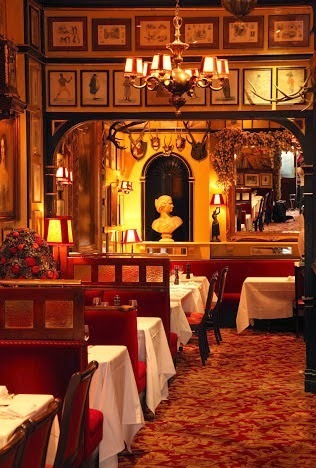 A glimpse of Rules interiorfrom their website, here
A glimpse of Rules interiorfrom their website, hereThe article also mentions Simpsons-in-the-Strand, The Punjab, Rowley's, Porters, and The Criterion, below.
 The Criterion
The CriterionYou might recognize it from one of the episodes of Downton Abbey last season. It's been its opulent self since 1874, and certainly was one of the places the "bright young things" went, back in the day. It's right on Piccadilly Circus, next to the Criterion Theater. Ed and I dropped in for a drink before going to see a very funny play, The 39 Steps; the theatre, dating from the 1870's, is way below ground and was used by the BBC during World War II as a bomb-safe broadcasting venue.
 My photos only partially convey the sparkle and shimmer of the walls, ceiling, and furnishings.
My photos only partially convey the sparkle and shimmer of the walls, ceiling, and furnishings.For more information on the Criterion restaurant, click here and enjoy a gallery of photos too.For more on the Criterion Theatre, click here. The 39 Steps is based on a 1935 Alfred Hitchcock movie, a thriller based on a John Buchan novel published in 1915. However, this is a farcical version, based on split-second timing and very funny lines, and four brilliant actors, as well as the excitement of the chase.
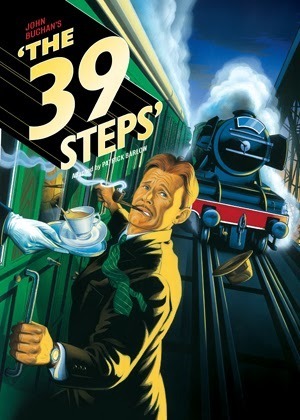 As of this writing the play is still running.
As of this writing the play is still running.The British Heritage article on classic London Restaurants (vol. 35, #4) also lists Rock and Sole Plaice, Langham's Brasserie, and the great seafood restaurant, Wiltons. And one more that I love: The Albert in Victoria Street (as well it should be).
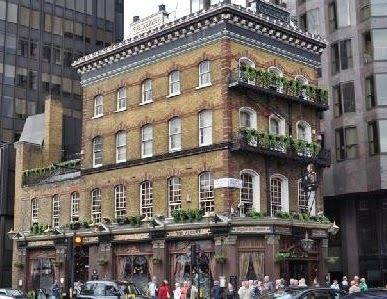 The Albert
The AlbertIt is a classic Victorian Pub (again, as it should be) and serves food in the Carvery and upstairs. The two pictures below are from a few years ago and show the interior before a recent re-do which highlights the 1860's look of the original, before it survived the Blitz and lots of neighborhood development plans.
 We got a good laugh from the sign to which my buddy Richard points. Indeed more seats!
We got a good laugh from the sign to which my buddy Richard points. Indeed more seats! We loved every minute and every morsel at The Albert.
We loved every minute and every morsel at The Albert.I am eager to see the new furnishings, soon, I hope. And while we are on the subject of restaurants, one of the funniest signs I saw was the one below, when we were exploring Windsor with our late great friend Hester Davenport.
 The Nell Gwynn Chinese Restaurant, Windsor
The Nell Gwynn Chinese Restaurant, WindsorKristine and I fell apart laughing at this. Wonder what the famous actress, courtesan, and special mistress of Charles II would think of this sign! At least they got the orange color right!!
Watch for more on food and restaurants, coming up when we tour England in September.
Published on August 01, 2014 00:30
Kristine Hughes's Blog
- Kristine Hughes's profile
- 6 followers
Kristine Hughes isn't a Goodreads Author
(yet),
but they
do have a blog,
so here are some recent posts imported from
their feed.



